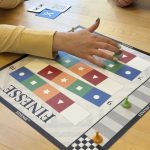Whist, the predecessor of Bridge, is a timeless card game played by four players in fixed partnerships. This guide covers the rules, strategies, and nuances of Classic Whist, making it easy for beginners to learn and enjoy its strategic depth. Whether you’re a budding Bridge player or simply curious, Whist offers a perfect blend of simplicity and complexity.
Start with Whist: A Guide to Winning Tricks


Start with Whist: A Guide to Winning Tricks
Whist is a classic card game and known as the precursor to Bridge. Indeed, a good portion of the play in a hand of Bridge is basically Whist. You have a partner, you win tricks, you apply basic techniques and strategies, and you can even communicate with partner by choosing certain cards to play. To help beginners learn the game of Bridge, we thought we’d start by teaching Whist. It’s basically Bridge without the bidding, although there are variations of Whist that include bidding (we’re not going to address them here).
And even if you don’t want to learn to play Bridge, you’ll find the game of Whist satisfyingly strategic, complex and simple at the same time. In this article, we are going to be talking about Classic Whist. There are many other variations, which you’ll see if you click through some of the resources at the bottom of the page.
Played by four players in two fixed partnerships, the essence of Classic Whist is to win tricks and score points. This guide gives a thorough breakdown of the rules and provides some strategies to help elevate your gameplay. And your partner’s!
Whisk and Swabbers – The History of Whist
Whist traces its roots back to the 16th century, originally known as “Triumph” and later evolving through various stages and names such as “Ruff and Honours” and “Whisk and Swabbers.” By the 18th century, it had developed into the game we now recognize as Whist. This card game became incredibly popular during the 18th and 19th centuries, particularly among the upper classes in Britain and North America, where it was often the focal point of social gatherings in parlors and salons. As we mentioned earlier, Whist also played a pivotal role in the development of other card games, including Bridge, which eventually surpassed Whist in popularity by the early 20th century. Despite the evolution of card games, Whist remains a celebrated part of card game history, known for its strategic depth and influence on later games.
Whist Basics
Number of Players: The game is played with four players, split into two teams of two – partners.
The Pack: A standard 52-card deck is used, and two decks are recommended—one for playing and the other for shuffling, ready for the next deal. Note: there are no jokers or wild cards in Whist
Rank of Cards: The ranking from high to low is Ace, King, Queen, Jack, 10, 9, 8, 7, 6, 5, 4, 3, 2.
The Dealer: At the beginning of a Whist game, people draw to see who is the first dealer, low card wins. The dealer shuffles the deck 7 times, then sets it to their right to be cut. Note: The designated Dealer rotates to the left after each hand.
The Deal: Cards are dealt around the table left to right, face down. Eventually each player will hold 13 cards.
Choosing Trump: The easiest way to choose trump is to start with clubs, then diamonds next round, then hearts, then spades then no trump. No Trump is when there is no trump suit, so all tricks are won at face value.
Another possibility would be to draw a card from the deck, call that suit trump, then shuffle and deal. People have been known to use a ‘trump marker’ to remind everyone what is trump.
Objective: The aim is to win more tricks than the opposition. Each trick won beyond the first six (the book) scores a point for the side winning it.
The Book: The first six tricks are called ‘The Book’ and are not counted in scoring. Tricks won beyond the first six (there are 7 in total) are scored. Note: The Book is also used in Bridge. You heard it here first.
Game on!
The Play: The player to the left of the dealer leads the first card and play continues clockwise (left left left). Each player must follow suit if possible. If you cannot follow suit, you can play any card (this is called a discard) or you can play a trump card.
Trumps: A card in the Trump Suit can be played when a player cannot follow the led suit. A trump card will always win a trick unless someone else plays a higher trump card. Note: You don’t have to play a trump card if you are not able to follow suit. You can discard another card instead. But you can never win a trick with a discard.
Winning Tricks: There are four cards played to each trick – play goes around the table once, each player contributing a card. The highest card of the suit led, or the highest trump if trumps are played, wins the trick. The player who wins the trick leads to the next.
Play continues until all the cards are played for a total of 13 tricks. Note: Tricks you win and tricks your partner win are scored together.
Scoring: Only tricks won beyond the first six contribute to the score. These are called ‘odd tricks,’ and each is worth one point. The total points, then, for one hand of Whist, is 7. This can vary in different variations of Whist, but for the purpose of this article, you score one point for each odd trick.
And that’s it! A pretty easy game, but with lots of depth. Before we look at strategies, let me ask you a few questions.
Q 1: You have the King of hearts in your hand, so you lead it. But the opponent’s Ace of hearts wins the trick. Can you think of a way to win your King of hearts?
Q 2: You have the King, Queen, and Jack of hearts in your hand. Can you think of a way to win a trick with the Queen?
Advanced Strategy and Tips
Opening Lead and Play of the Hand
If you lead an Ace, then anyone who holds the King will now have a winner. It’s a good rule of thumb to lead top of a sequence. Lead the Ace if you also have the King. Or lead the King if you have KQJ. Leading top of a sequence can help ‘develop’ your lower cards. Develop is what we say when your little cards grow up to be winners!
It’s often a good idea to lead from your longest and strongest suit. If there’s not sequence at the top, lead your 4th highest card.
Oh and here’s a good tip: return your partner’s lead when you are able to do so!
If there’s a trump suit, and you have a single card in another suit, you might lead that single card (it’s called a singleton) hoping that later partner can lead that suit and you will be able to trump it (you can say ‘trump it’ or you can say ‘ruff’)
Never lead trump unless you have 5 or more, and in particular, if you have top honours. It is usually good to lead with them in order to draw your opponent’s trumps so they can’t be ruffing your winners.
Remember – you and your partner are a team. It doesn’t matter if you win the trick or if they win the trick. Sometimes your weak suit could be your partner’s strongest!
The choice of what card to lead, or even the choice to follow suit, can convey significant information about your hand to your partner.
Pay close attention to the cards your partner plays. Their choices can provide insights into their strengths and weaknesses, helping you make more informed decisions about your own play.
Memory is Key
You’ll need to keep track of which cards have been played, especially the trumps and other high cards. This knowledge can significantly influence your strategy in the later phases of the game.
Let’s go back to that King of Hearts as an example. If someone at the table has played the Ace of hearts, you know your King of hearts is now a winner. Next time you win a trick, you can play the King of Hearts. But, you had to remember that the Ace had been played. It’s the same with a three of hearts. If you’ve been counting and you know that 12 heart cards have been played on earlier tricks, you will know that your lowly heart 3 is a winner, especially if you’re playing No Trump. These are examples of paying attention and remembering cards. But don’t fret – it’s only 13 cards!
Agreements
Card Play Agreements are pre-established strategies that can help communicate between partners without words. Understanding and using agreements can greatly enhance the synergy between you and your partner. Some of the ones listed below are the same agreements often used in Bridge as well.
- You might give ‘count’ by playing your cards in a certain way when following suit. For example you might play a high and then a low card to show an even number of cards in a suit, and a low, then a higher card to show an odd number of cards in a suit.
- You might give ‘attitude’ by playing either a high or low card – high if you like the suit partner has led, or low if you don’t like it.
- Some people play only count, or only attitude, and some people might mix it up by playing one way on the opening lead and the other way the rest of the hand. Of course, you’re not going to waste any honour cards while doing this!
OK let’s give an example.
Partner leads the Ace of hearts, and you have two little hearts, the 5 and the 2. You and partner have agreed to play ‘count’ so you play the 5 of hearts on partner’s Ace. then you play the 2 of hearts on partner’s King. Partner now knows a lot about your hand! Not only does he know you have an even number of hearts (and likely only 2) he also knows how the hearts are sorted in all the hands, which helps him make assumptions about the other suits as well.
Leverage Your Position
Depending on your position in the order of play (first, second, third, or fourth to play in a trick), different strategies can be employed. For example, as the fourth player, you have the final say in the trick and can choose to use a higher card to win or a lower card to conserve strength for future plays. Of course, if your partner has already ‘won’ the trick, you can play something small. Or, if you have a card play agreement with partner, you can play a card that tells them details about your hand.
Focus on Team Play
Remember that Whist is a team game. Collaborative play, where you and your partner work cohesively, often outweighs individual brilliance. Winning a trick is less important than ensuring your team wins the game.
Regular Practice and Review
Continuous practice and review of past games can dramatically improve your understanding and proficiency in Whist. Observing others play, discussing strategies with your partner, and regular review of the basic and advanced tactics are all excellent ways to enhance your gameplay.
One of the people key in my learning to play Bridge used to deal out 13 hands face up, pick trump, and then we would play the hand card by card. He would give advice to me on each card I played. It was extremely helpful.
The Answers
Remember we asked you two questions at the start of this article? I bet you can answer them now!
Question One
You have the King of hearts in your hand, so you lead it. But the opponent’s Ace of hearts wins the trick. Can you think of a way to win your King of hearts?
Answer: If partner has the Ace of hearts, your King will eventually win a trick. If the opponent leads the Ace of hearts, your King will ‘grow up.’ If an opponent ‘underleads’ their Ace of hearts, your King will win! And finally, if the Ace of Hearts is on your right, meaning if it’s in your right hand opponent’s hand, it’s likely you will eventually win your King. The wrong answer here is to lead your King.
Question Two
You have the King, Queen, and Jack of hearts in your hand. Can you think of a way to win a trick with the Queen?
Answer: This is simpler than question one right? Play the King, and if an opponent has the Ace they will win the trick. But now, with both the Ace and King gone, your Queen will be a winner on a following trick.
I posed these two questions to give you a lovely taste of the intricacies of card play – isn’t it wonderful?
Whist Resources
A series of articles on How to Play Whist has been written by Brian Furniss and can be found on Simon Lucas Bridge Supplies.
Websites where you can play Whist online free and without setting up an account. Good for practice.
Card Games – Whist. This is a very simple page where you can play a very simple game of Whist.
Solitaire Bliss – Whist This is also a reasonable play table. Trumps are indicated in the bottom left corner.
The Rules of Whist
Pagat.com – as always, John McLeod’s Pagat is one of the best sites online for card game rules.
Cool Old Games – Paul Dunlop gives a good ‘rules of Whist’ recap.








